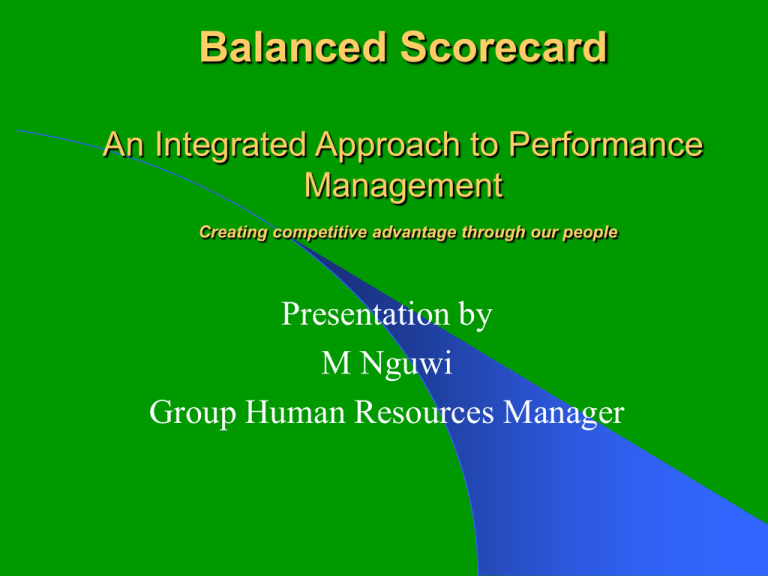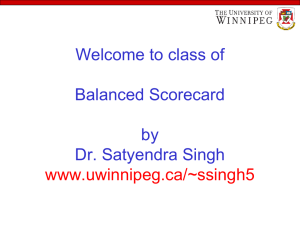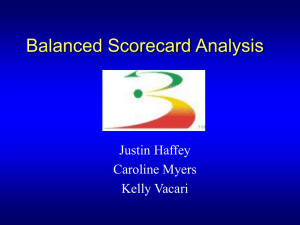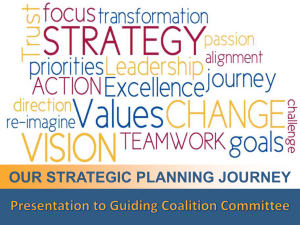Balanced Scorecard
advertisement

Balanced Scorecard An Integrated Approach to Performance Management Creating competitive advantage through our people Presentation by M Nguwi Group Human Resources Manager BALANCED SCORECARD LINKING STRATEGIES TO ACTIONS LINKS FOUR PERSPECTIVES: Growth & Profitability Human Capital Clients Operational Excellence SOURCE: KAPLAN AND NORTON 2 What is a Balanced Scorecard At the highest level, it is a framework that helps organisations translate strategy into operational goals/objectives that drive both behaviour and performance. ORIGIN Concept developed by Robert Kaplan & David Norton Essentially A Strategic Management system Also a Corporate Performance Management System 3 The Balanced Scorecard Aligns strategies, processes, resources and behaviour – Defines what to measure Identifies lag and lead indicators metrics – Defines how to measure Provides objective and feedback to each employee – Operationalise the measures 4 The Premise Behind the Balanced Scorecard Is that Measurement Motivates Behavior The Premise Measurement Communicates Values, Priorities And Direction The Conclusion Measurement Must Be Linked To Strategy Strategy Balanced Scorecard Measurement To Communicate, Not To Control 5 The Balanced Scorecard Is Based on an Understanding of the Basic Building Blocks of the Strategy Financial Perspective Return on Investment Revenue Strategy Productivity Strategy Sources of Growth Sources of Productivity Customer Perspective 2. The value proposition of target customers Value Proposition Price Quality Time Function 1. The economic model of key levers driving financial performance Image Relatioship Internal Process Perspective “Build the Brand” “Make the Sale” “Deliver the Product” “Service Exceptionally” Learning & Growth Perspective Staff Competencies + Technology Infrastructure + Climate for Action 3. The value chain of core business processes 4. The critical enablers of performance improvement, change and learning 6 We Use the Scorecard to Articulate Strategic Hypotheses in Cause-effect Terms And Realize the Vision Financial Results Customer Benefits Internal Capabilities Knowledge, Skills, Systems, and Tools To Drive Financial Success... Needed to Deliver Unique Sets of Benefits to Customers... To Build the Strategic Capabilities.. Equip our People... BSC Terminology Strategy Map: Diagram of the cause-and-effect relationships between strategic objectives Strategic Theme: Operating Efficiency Financial Profitability Fewer planes More customers Statement of what strategy must achieve and what’s critical to its success How success in achieving the strategy will be measured and tracked The level of performance or rate of improvement needed Key action programs required to achieve objectives Customer Flight Is on time Internal Fast ground turnaround Lowest prices Goals Measurement Target • Fast ground • On Ground Time • On-Time • 30 Minutes • 90% turnaround Initiative • Cycle time optimization Departure Learning Ground crew alignment 8 Some of the Indicators of Good Balanced Scorecard 1. Executive Involvement Strategic decision makers must validate and own the strategy and related measures 2. Cause-and-Effect Relationships A good Balanced Scorecard will “tell the story” of your strategy in actionable terms. Every objective selected should be part of a chain of cause and effect linkages that represent the strategy 3. Balance between outcome and leading measures There should be a balance of outcome measures and leading measures to facilitate anticipatory management 4. Financial Linkage Every objective can ultimately be related to financial results 5. Linkage of Initiatives and Measures: Each initiative should be based on a gap between baseline and target. Some Goals of the Balanced Scorecard Provide a generic framework to translate strategy into operational terms Create a systems approach to form an integrated Strategic Management Process Provide a clear line of sight to the vision and strategy of the company Provide a tool for communicating the : • strategy, and • processes and systems required for implementing the strategy Draw a cause and effect roadmap to stakeholder value – shareholder, customer, and employee. How Does the Scorecard Benefit Your Organization? Improves management effectiveness by having a shared and actionable view of the strategy Optimizes and ensures strategic outcomes for a given set of resources Enables employees to work in a coordinated, collaborative fashion towards organizational goals Speeds time to value through faster more informed decision-making on time and resource allocation Accelerates the approach, and its accuracy to the strategic destination 11 CONCEPT Imagine entering the cockpit of a jet airplane and observing that that there is only a single instrument ability to exploit intangible assets has become far more decisive than their ability to invest in and manage physical assets Most companies operational and management control systems are built around financial measures and targets The scorecard introduces four new management processes that contribute to linking long term strategic objectives with short term actions 12 What is on the dashboard? “The financial success of our organisation increasingly depends on intangibles: our relationship with clients our organisational effectiveness our ability to attract, leverage and retain the best people 13 WHERE DO WE START? Guiding Principles of Performance Management Develop and Articulate a Clear Strategy Create a Continuous, Flexible Performance Management Process Actively Communicate Performance Goals and Targets Establish Specific, Ambitious Targets Based on Benchmarks Identify and Focus on the “Vital Few”: Establish a Balanced Measurements Portfolio Monitor Results at Specific, Regular Intervals to Assess Progress Align Reward Systems with Measures to Reinforce Desired Behaviours 15 Why is Performance Important? PERFORMANCE is about RESULTS… measurable results Need for the organisation to benchmark performance against world class standards Enables efficient and effective use of resources Motivate high performers Identify inadequate performance early 16 CREATING A WINNING STRATEGY Critical Questions: –Are we doing the right things? –Are we doing it right. Plot your Value Chain First Identify your customers and what they want? What is the process to satisfy customer’s wants? What kind of input to the process do you need? And who supplies that? Everyone must understand who our customers are and what their requirements are. 18 What is our Value Proposition? Existence of our business relies on two important elements; – The value proposition that we offer different stakeholders(clients, shareholders, employees etc.) – The ability to deliver that value, both in the short and long term 19 “If you don’t know where you want to go, it does not matter what root you take.” 20 Managing Strategy: Four processes Translating the vision • Clarifying the vision • Gaining consensus Communicating & Linking • Communicating & educating • Setting goals •Linking rewards to performance measures Feedback & Learning Balanced Scorecard • Articulating the shared vision • Supplying strategic feedback • Facilitating strategy review and learning Business planning • Setting targets • Aligning Strategic initiatives •Allocating resources •Establishing milestones 21 Four Barriers to Strategy Vision Barrier – strategy not understood by those who must implement it … and not translated into objectives/goals People Barrier – personal goals are not linked to strategy implementation Management Barrier – Management systems are designed for operational control and not strategy Operational Barriers – key processes are not designed to leverage the drivers of business strategy 22 Translate a Strategy into Operational Terms Targets Measures “To satisfy our stakeholders, what financial objectives must we accomplish? Goals Financial/Profit & Growth Targets Measures Targets What do wee need to change in our Infrastructure or intellectual capital to achieve Our operational excellence goals Measures Human Capital Objectives Targets Measures Objectives What is the customer Value Proposition That will create the financial rewards we are seeking “To satisfy our shareholders and customers, what business processes must we excel at?” Vision and Strategy Goals Operational Excellence Client 23 The Four Perspectives Feedback / Results Strategy Deployment Strategy Implementation Financial or Profit & Growth To satisfy our stakeholders, what financial objectives must we accomplish? Clients What is the customer Value Proposition That will create the financial rewards we are seeking Operational Excellence In which internal business processes must we excel in order to deliver our value proposition as described in the client perspective and finally reach the goals in the financial perspective Human Capital Actions What do wee need to change in our Infrastructure or intellectual capital to achieve Our operational excellence goals 24 Balanced Scorecard: Evolved Framework The Vision & Strategy Financial To satisfy our shareholders, what financial objectives must we accomplish? Effect Customer To achieve our financial goals, what customer needs must we satisfy? Results Internal Business Process Cause To satisfy our customers, in which internal business processes must we excel? Innovation, Learning & Growth To achieve and maintain a competitive position, how must the organization learn and improve? Actions 25 A Good Balanced Scorecard Tells The Story of Strategy To satisfy our shareholders we must…... How do we wish to be perceived by our customers? Financial Perspective Return on Investment Increase Revenue Streams Reduce Costs / Improve Productivity Customer Perspective Price Quality Time Functionality Image Relations Internal Process Perspective What must we excel at? How can we continue to grow and create value? Build the Brand Make the Sale Setup the Service Service the Customer Learning and Growth Perspective Staff Competencies Technology Infrastructure Change Agenda Critical Success Factors and Measures need to be developed across the four perspectives Figure 5.3 Strategy Interpretation – Simplified Business Model of FSC Management Actions - Cause Business Results Required - Effect Improvement & Learning Perspective Internal Process Perspective Increase Employee skills and productivity Cross - sell products and services through lifetime relationships Build up large customer portfolio with more sales and customers Achieve dramatic sales goal Technology enabled revenue growth Dealing with members efficiently and effectively High Customer Satisfaction Achieve lower cost ratio vs competition Learn and embed compliance disciplines Develop full range of competitive products Innovative approach to maximise investment returns Customer Perspective Financial Perspective Increase value of members fund in line with all share index Balanced Scorecard Benefits • Improved Long-Term Financial Performance • Improved Level of Customer Satisfaction • Focused Communications on What’s Important • Improved Level of Employee Satisfaction Based on Better Understanding of Value of Individual’s Contributions • Improved Mechanism to Identify Performance Variances of Key Processes 28 Financial Perspective This indicate if company strategy, implementation and execution are contributing to the bottom line. Measurement of operating income, returns on capital or more recently EVA. Strategic themes include revenue growth and mix, cost reduction and, asset utilisation and investment strategy. Our revenue normally grow from finding new sources or by increasing the client/customer value proposition Looks at things like; – Revenue growth – Increase market share – Improve cost structure 29 – Reduce admin costs Client Perspective This is the most important one because it’s the one that facilitates the funding of all others Some of the most valuable Customer Propositions are; – Product leadership – Customer intimacy Measure performance in growth and identified market segments: - customer satisfaction. - customer retention. - new customer acquisition. - fast credit approval. - market and account share in targeted segments. - specific measures on the value proposition that the company will deliver to customers in targeted market segments e.g.. short lead times, on time delivery, innovative products and services, anticipation of emergency needs, new products. 30 Operational Excellence Identify critical internal process in which the business must excel to enable: -delivery of the value proposition that will attract and retain customers in targeted market segments. -satisfy shareholder expectations of excellent financial returns. The measure should focus on internal processes that will have the greatest impact on customer satisfaction and achieving an organisations financial objectives. Traditional approaches attempt to monitor and improve existing business processes. The scorecard will usually identify new processes at which the organisation must excel to meet customer and financial objectives (innovation). 31 Human Capital Identifies the infrastructure that must be built to create long term growth and improvement. Three principle sources: – people - reskilling – Management skills compensation competitiveness – systems - enhance IT (real time, accuracy) – organisational procedures - retention, training, skill, satisfaction. ** Unlike buildings and machinery support functions are intangible assets worth nothing unless they succeed in their mission. 32 Some examples of Key BSC themes & measurements Financial/Profit & Growth – Return On Investment – Revenue growth percentage – Economic Value Added – Market Share Client – Customer satisfaction – Customer Retention & referrals – maintaining highest reputation – Value – Customer payment patterns 33 Key BSC themes & measurements Examples Operational Excellence Human Capital – Error, waste & rework – Reducing Cycle time – Yield – On-time delivery – Project Deadlines – Core Competence deployment – – – – – rates Employee Satisfaction Employee turnover Training Rewards, Recognition & Compensation patterns Quality Improvement rates 34 The Cause & Effect Relationship in the BSC There is an important sequence between the four perspectives – Financial/Profit and Growth – (Make a profit) – Clients(By satisfying your customers needs) – Operational Excellence(through being able to deliver value) – Human Capital (by having the necessary knowledge and tools available) 35 Linkages to the Group Balanced Scorecard Financial/Profit & Growth Client Service Operational Excellence Human Capital Influences Financial/Profit & Growth Client Service Operational Excellence Human Capital Group BSC RFH Business Unit BSC RBF, RFS, RDH,RSB Support Functions Teams & Individuals 36 Alignment using the Balanced Scorecard Corporate Financial/Growth & Profitability Client Operational Excellence Strategic Capability- Human Capital SBU’s Individual Financial/Growth & Profitability Client Key Result Areas Operational Excellence Strategic CapabilityHuman Capital 37 Translating Group Objectives for each Level Step 1 – a group scorecard defines overall strategic priorities and context Step 2 – Each SBU develops a develop BSC consistent with the corporate strategic agenda Step 3 – Each support department develops a scorecard to support the internal customers Step 4 – Teams and individuals develop scorecards consistent with their SBU and group strategy 38 Linking Objectives/goals may cross over more than one perspective. We usually start at the top with outcomes and work our way down, looking at what enables (drives) the outcome. 39 Strategic Goals Establishing strategic goals is the first step in building the Balanced Scorecard. Strategic goals establish direction in concrete terms. For example: “By the year 2003, we will grow revenues by 45%.” Strategic goals anchor the rest of the process. Strategic goals should fit with the vision and mission of the organization. 40 Set Goals for Each Strategic Perspective Strategic Perspective Client Service delivery and demonstrating value to our clients Human Capital Develop and utilize resources intelligently Financial Achieving profitable revenue growth Operational Excellence Developing and driving improved common business processes Goals Develop effective client care meetings Devote substantial time to people development Grow revenue Ensure smooth handover of spectrum Measures Client feedback No: of people trained in essential skills Revenue growth Time frame Targets Average rating of 4 5% of the employees to have gone for customers service training By 45% Handover to be effected by end of March 2002 41 Strategic Goals Goals need to be expressed in concrete terms You can look at past performance or future performance to establish goals Goals need to be agreed upon and communicated within the organisation. 42 “If you don’t know where you’re going any road will take you there.” Goals are Roadmaps to the Vision ‘If you can’t measure it, you can’t manage it’ ‘Measuring the success(or “failure” of your strategy” Measure - How performance against set goals is monitored For each strategic Goal, you need one measurement. Measurement provides us with feedback on meeting the strategic goals Most organizations will use many of their existing measurements. Organizations requiring major change should include driver type measurements. 45 Measurements A good balanced scorecard should consists both outcome and driver measures Financial and Customer will have mostly outcome type goals Operational Excellence and Learning & Growth may include several driver type goals 46 Measurements Outcome measures – Advantage - objective and easy to capture – Disadvantage - focused on the past, not current Drivers – Advantage - Predictive and leading the organisation – Disadvantage - Difficult to drive and support 47 Measures: Lag/Lead Comparison Strategic Goal Lag / Outcome Measure Lead / Driver Measure Excellence Human Capital Operational Client Financial Most of your financial measures are outcomes *Operating Profit * Percentage Growth in Revenues *Return on Capital *Net Profit Most of your customer measures are outcomes * No: of new customers * Customer Satisfaction Rating *Customer Retention Rate * Market Share Mix of outcomes * Revenue Mix * Hours Spent with Customers * Competetive Pricing Variance and drivers * Waste as a % of total value Most of your Learning and Growth measures will be drivers * Employee satisfaction index 48 * Training Hours Completed Lead/Lad Measures Leading and lagging indicators only makes sense relative to one particular strategic goal. A lagging measure for one goal may therefore be used as a leading indicator for another objective Targets The term used to describe what is expected for the measured results/required level of performance Once you establish measurements, you need to set a target for each measurement. Targets push the organization to a required level of performance. Targets put focus on the goal, expressing the specifics of the goal. When an organization hits its targets, then it has successfully achieved its goals. 50 Targets Establish financial related targets first Continuously review targets Target setting enables the organisation to: - quantify the long term outcomes it wishes to achieve. -identify mechanisms and provide resources for achieving those outcomes. -establish short term milestones for the financial and non-financial measure on the scorecard. 51 Sources for Determining Targets Strategic goals Industry benchmarks/best practice Incremental improvements to existing performance levels 52 Reporting Issues How often should the Balanced Scorecard measures be collected? Who should collect? Collection process – owner and collector Who should trend and analyse the Balanced Scorecard measures? How often should measures be changed? 53 Best practice in global Corporations • Use a balanced set of performance metrics • Have quantifiable or verifiable (qualitative) goals • Support the values of the organisation • Align goals to strategy, and focus on development • Use multi-rater feedback as part of the process • Have a global philosophy/approach, but allow for local adaptation 54 Everybody Wins Customers win because… every employee understands the importance of customer satisfaction and the part they each play in delivering it. Senior management win because… corporate performance is improved through the alignment of effort behind the strategy, and the visibility of the drivers for corporate performance. Middle management wins because… there is better information at their fingertips to make resource allocation and prioritisation decisions, changes in priorities are communicated more rapidly and consistently, team management is easier and morale improved. All staff benefit because… they see how they fit in and how to succeed, they know their contribution is recognised and valued and... We no longer expect a job for life - we do want employability for life! Skills and competencies of all staff are clearly valued, and can be updated and developed. The importance of personal development can be clearly recognised and valued, including personal development plans and tracking of progress, and the impact that skills development has on achieving objectives can be appreciated. 55 Implementation Presentation to Executive & Management Contributions by Executives And Management Project Team: – GF Chinamasa – E Chikaka – L Mkuzvazva – Dube – T Samusodza – C Vengesa – M Nguwi – Mapenzauswa Design Meetings Executive & Senior Managers Strategy Workshop & Goal Setting Other Managers & Employees Perf Mgt Training & Roll Out 56 Implementation Issues & Concerns Change management comes first Ensure all employees share in the understanding of our performance management strategy Employees need to know how the road looks ahead, which route to follow and how far we have come Pilot project ideal in big organisations Apart from BSC project team, involvement of Line managers is crucial Data collection – in developed counties and big organisation software support used Involvement of both management and employees critical 57 Pitfalls Getting bogged down in too many goals and measures Vocal, but not real commitment from management or – simply no commitment as all Failing to realize that the scorecard like any management instrument is based on assumptions e.g if our strategy is based on the assumption that people want quality, and our measures assures us that we have that quality, but people still don’t buy use our products – then maybe it’s time to change the assumption. 58 BENCHMARK INFORMATION Performance Ratios Financial Institutions 60 Thank You 61 QUESTIONS 62








